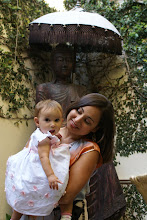With a new baby comes a tsunami of excitement and curiosity. After that comes a wave of worries and concerns, and perhaps a bit of comparison. As new moms get together in their circles and share stories of their growing miracles, it is often difficult not to wonder if your baby is Normal, Ahead of the Class, or Trailing Behind. If at any time we feel as though ours is just not quite reaching the milestones on time, some of us try to speed things up a bit.
A FEW WORDS OF CAUTION FOR SOME PARENTS WHO JUST CAN'T WAIT.
MY BABY IS NOT STTING
In Utero we all start out with one curve, a big thoracic C curve. So, in the first few months of life it may help to prop up your infant slightly after meals, or carry her around in a sling. But if this continues on after she is able to hold her head up strong, even 10 degrees can this little of bend can impact her developing spinal curvature. At this point it may help to lay her on her back, but prop up the surface she is on. The road to unsupported sitting is paved by gradual muscle building and all of the stages prior to it are responsible for targeting muscle groups in their proper order. If a stage is skipped, some deep core muscles will be weaker which will interfere with the milestones ahead. Don't force your baby to sit upright, near the 90 degree angle. Why?
- Sitting places the greatest load on our spine and discs. Unnatural early sitting will put greater stress on vertebrae and discs, dehydrating them, slowing growth, and decreasing the quality of bone deposition.
- A baby left sitting in a BUMBO chair (even for 15minutes daily) before they are able to sit on their own does not allow for paraspinal muscles to strengthen and support the column, creating future instability in the spine and pelvis.
- The load of a slouching baby pulls the head forward and places extra pressure on the middle thoracic curve. This begins to affect neck muscles, cranial structures, and their digestive system.
MY BABY IS NOT EATING SOLIDS
At the grocery store, baby food is mashed up and ready to be served at 3 months of age. So, you pick your brand, make sure there is an assortment of flavors and colors and bring it home for your hungry little monster to try. Whether you are introducing this shift after breastmilk or formula, don't be discouraged if your baby turns his head and starts to fuss. New research has indicated that it is beneficial to breastfeed exclusively until a minimum of 6 months. Why?
- The digestive system is just learning and growing. The gut needs to develop a sufficient enough amount of flora and good bacteria to help your baby handle the new larger food protein particles that will be coming his way. A great indicator of this is the eruption of teeth, which nature would not allow to happen until the body was able to accept what the teeth have ground up.
- Physically, the baby needs to know how to sit on his own, unsupported, which is another indicator that the abdominal muscles have developed enough to support the digestive system.
- The immune system is also affected directly via the gut. If a food is taken in that cannot be properly digested, the nutrients don't get absorbed, and the body launches an immune attack on this food particle thinking that it is a foreign bacteria or virus. If this food continues to be presented time and time again, the baby may develop an allergy to it as well as other foods similar in composition. The allergy does not always have to present as hives and difficulty breathing, it may come in the form of vomiting, spit up, stool change, or a new skin rash.
So, as a rule, don't force the food in until your baby is sitting up, accepts it, and has some teeth that have come through.
MY BABY IS NOT WALKING
There is not enough stress placed on the importance of the crawling stage. Many parents are happy when their baby goes directly from sitting to standing, and then walking. It is important to remember that this stage is there for a reason, and skipping it will have some major negative implications. Why?
- The cross-crawl pattern stimulates brain centers responsible for reading comprehension. While your baby can't really do either right now, these centers need to be prepped for when they start to learn letters and numbers.
- Crawling allows for opposite muscles to strengthen and coordinate. This prevents overdevelopment of one side of the body and allows for greater muscular support when the baby is ready to start walking.
- Proprioceptors in the brain are also being stimulated as your baby starts to discover where they are in space and they begin to learn how to control the objects around them.
- Putting babied in walkers before their knee and hip joints are strong enough to support their weight can create ligamentous laxity and alter their gate, foot arches, and place undue stress on developing disks and bones of the spinal column.
If your baby is between 16 and 18 months and is unable to walk on their own it is advisable to contact your pediatrician, chiropractor, or other development specialist.



No comments:
Post a Comment